Distillation & Evaporation
- Know-how is the key -
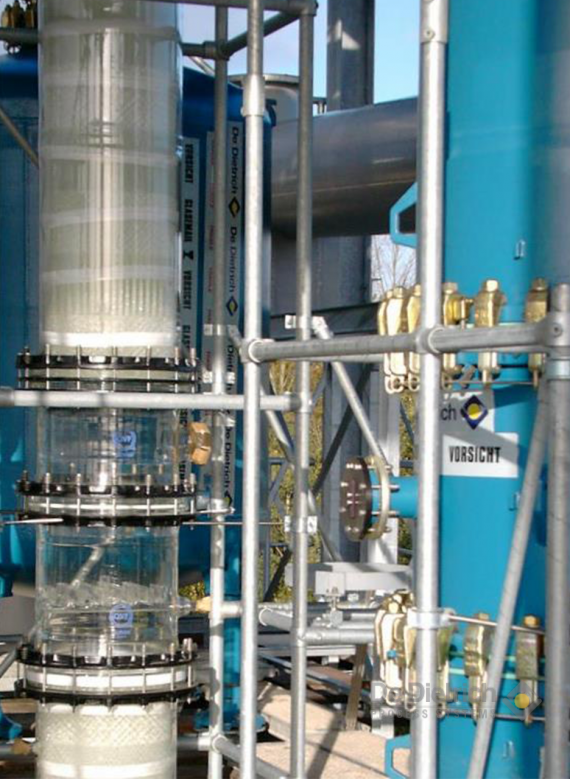

General Information
Distillation as a thermal separation process is used if the chemical composition of the vapor phase is different from the chemical composition of the liquid phase. This is mostly the case for mixtures of products having different boiling points means different volatilities. Process and plant design to separate, purify, concentrate and recover chemcial components by distillation if one of our core competences.
There are also liquid mixtures forming at a specific ratio a vapor phase with the same composition. These azeotropes and cannot be split further by distillation. If this has nevertheless to be done the process conditions have to be modified so that the composition in the vapor phase becomes different from the liquid phase. This can be realized by e.g. changing the operating pressure or adding another compound. Adding a compound with a low volatility reducing the vapour pressure of one the mixture components lead to a so called extractive distillation as realized e.g. for the QVF® nitric acid and QVF® hydrochloric acid concentration processes.
Another situation occurs if the liquid phase consists of non-miscible liquid components. In that case the vapor pressure of the liquid components are not reduced by each other and the vapor pressure of each liquid phase add up so that the higher boiling component becomes also volatile leading to a e.g.hydro-distillation.
The Basic Process Steps
The distillation process requires an evaporation and a condensation step. When evaporating a mixture the component with the lowest boiling point or highest volatility evaporates first as its content in the vapor phase is higher than in the liquid phase and the content of the higher boiling component becomes higher in the boiling liquid phase. The vapors are then liquefied by the condensation step. Depending on the difference of the boiling points and the required purities of the products one single distillation process can be sufficient. If not, the condensate will be used for a second distillation process. The less the volatilities resp. boiling points of the individual products are different from each other the more distillation processes are necessary to separate the products to a given degree.
The Evaporation Step
The basic process step of a distillation is the evaporation process. Depending on process mode, quantities, boiling temperature and the maximum permissible temperature of the product to processed different types of evaporators have been developped. De Dietrich Process Systems has designed for decades such evaporators providing a proven functionality. De Dietrich® glass-lined steel and QVF® borosilicate glass are ideal materials due to their universal corrosions resistance. Otherwise we will also be pleased to provide such equipment in stainless steel or other alloys and metals.
Evaporation under reduced pressure
If products cannot be heated up to their boiling point at atmospheric pressure without the risk of their thermal degradation or if the temperature of the heating media is not high enough the boiling temperature in the evaporator will have to be lowered by reducing the pressure in the evaporator.
The minimum reasonable vacuum and hence minimum evaporation temperature for a stirred vessel is set by the hydrostatic pressure at their bottom. With other types of evaporators with less hydrostatic pressure the vacuum can be lowered further:
- Forced and natural circulation evaporators : 50 mbar
- Horizontal evaporators : 10 mbar
- Rotary evaporators: 5 mbar
- Falling-film evaporator: 5 mbar
- Thin-film evaporators: 0,1 mbar
- Short-path evaporators: 0,001 mbar
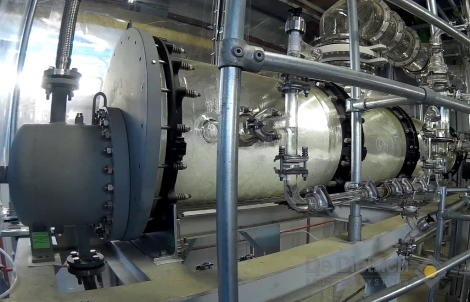
Empty line to generate FULL WIDTH
The Condensation Step
The design of the condensations sections for all these evaporators down to 1 mbar do not much depend on the type of evaporator but mainly on:
- Capacity
- Condensation temperature and pressure
- Temperature and kind of the cooling media
- Required temperature of the condensated liquid
- Corrosion requirements
- Contamination probability
- Space requirements
According to the above requirements the most suitable condensation arrangement has to be defined from:
- Downcoming condensation
- Up-rising condensation
- Counter or co-current flow of the distillate and the cooling media
- Liquid/liquid phase separation
For corrosive applications De Dietrich Process Systems has developed and manufactures a wide range of heat exchangers combining highly corrrosion resistant materials as QVF® borosilicate glass 3.3, De Dietrich® glass-lined steel, PTFE and SiC.
- Coil-type heat exchangers
- Shell& tube heat exchangers
- GMP-Heat exchangers
- CORE-Therm heat exchangers
- Integrated solutions as the THERMIPACK®
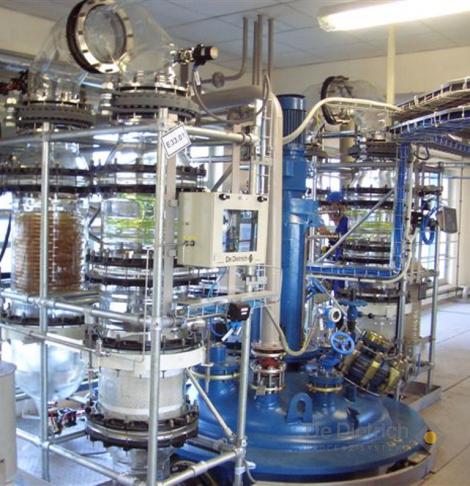
empty line to generate FULL WIDTH
Rectification
If a single distillation process is not sufficient to get the required degree of separation a subsequent distillation process of the condensated liquid is required. The not evaporated liquid of the subsequent distillation is fed back to the first distillation process. Similar distillation processes can be added further. Such a sequence of distillation processes or distillation stages can be realized in a more efficient way by a column with trays between the evaporator and the condensation section providing a counter current up-rising vapor and down-coming liquid flow. The function of the trays in such a rectification column can also be realized with packings.
The choice of the most suitable column internals depend on:
- Required number of distillation stages
- Flow rates and densities of the uprising vapor and the down-coming liquid
- Pressure drop resp. max permissble pressure/temperature in the evaporator
- Corrosion resistance
- Available height
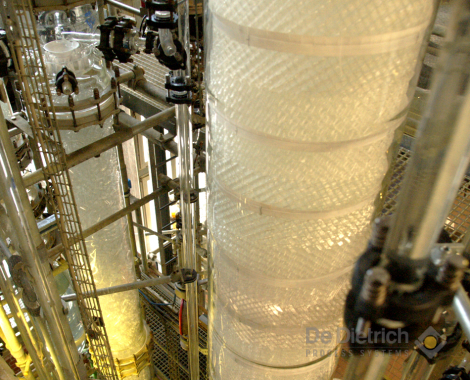
Operation Mode
The distillation or rectification process can be carried out batch wise and continuously.
For a batch operation the feed is fed into the evaporator mostly a stirred heated vessel. The composition of the distillate and the bottom product change along the time. This means e.g. that the purity of the distillate might be good at the beginning of the distillation but not more later when the concentration of the light bolilng component in the evaporator decreases.
For a continuously operated continuously operated rectification system the location of the feed point depends on the composition of the feed with respect to the composition of the bottom and top product. The composition of the distillate and the bottom product will no more change along the time after the column got to the steady state. The purity depends on the separation efficency realized in the equipment.
Range of Solutions and Services
De Dietrich Process Systems provides solution from pilot scale up to industrial scale.
We provide process design, complete process plants and components for various applications with a special focus on processes requiring corrosion resistant, easy to clean or transparent materials.
Equipement size:
- Stirred evaporators: 6l to 120m³
- Columns: DN30 to DN2400
- Condensers: 0,3m² to 30m²
Services:
- After-sales service
- Process liability
- Documentation
- Commissioning
- Installation
- Transportation
- Manufacturing
- Procurement
- Detailed Engineering
- Risk analyses
- Basic Engineering
- Feasibility studies
- Tests and Trials
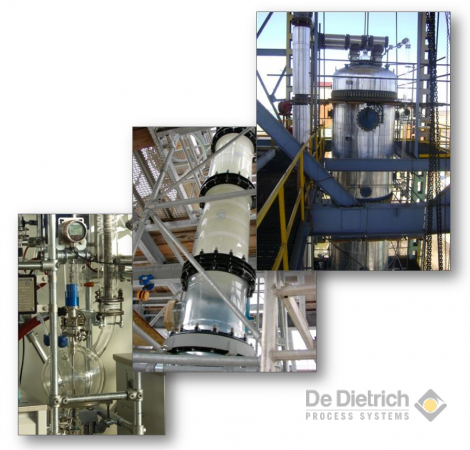
Your Benefit
We can design the most suitable distillation process based on our chemical process know-how, experience, simulation tools and tests in our experimental hall for your application. The process will be carried out in plants constructed and realized by our experienced engineering teams using reliable key components from our own production.
You would have one single liable partner for the process, functionality and quality.
You would receive the most sustainable solution with lowest investement and maintenance costs.
Applications














